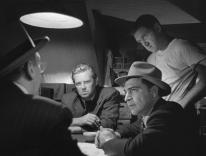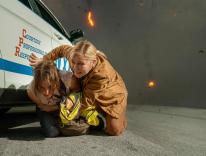
German director Christian Petzold’s tenth feature film, Afire—which premiered this year in Berlin and has now arrived in American theaters—dramatizes with understated intelligence the kind of psycho-social tension that, in the age of pandemics and climate emergency, we seem doomed to face, forget, and face again. In some ways a minor work—it has a short running-time, a cast you can count on one hand, and an almost too-simple plotline—Afire nevertheless marks a new level of ambition and achievement for Petzold. It is a chamber piece centered on youthful preoccupations against a backdrop of profound but easily ignored risks, a critique of bourgeois self-obsession that remains grounded in personal predicaments. Its simplicity and even-handedness are the result of decades of steadily increasing technical mastery and thematic clarity.
Born in the early 1960s in northwest Germany, Petzold rose to prominence as a member of the Berlin School, an unofficial movement of filmmakers exploring the emotional fallout of German reunification. What unifies the Berlin School is not so much an explicit aesthetic or political program as a careful and self-possessed sensibility. Slowly, over the course of the past twenty years, Petzold has emerged as the most internationally recognizable of this group. Early films such as 2000’s The State I Am In and 2007’s Yella demonstrate the poise of his narrative approach, taking on historical forces—the long shadow of revolutionary violence, the corruption intrinsic to capitalism—by allowing their textures and nuances to emerge in the lives of the people subject to them.
Petzold’s reputation grew rapidly after 2012’s Barbara and 2014’s Phoenix, both starring Nina Hoss and Ronald Zehrfeld. Barbara, set in 1980 in East Germany, tells the story of a doctor (Hoss) who is subjected to invasive surveillance by the Stasi as she plots her defection to the West. Meanwhile, she finds herself enmeshed in the fragmented society of the village to which she has recently been re-assigned by the authorities. As she cares for a pregnant girl from the nearby labor camp, she develops a tense relationship with Reiser (Zehrfeld), the chief physician whose murky past led to his own harassment by the state, for which he now works as a reluctant informant.
Phoenix takes place in the bombed-out remains of postwar Berlin. Nelly (Hoss), recently liberated from a concentration camp and recovering from facial reconstructive surgery after a bullet wound, returns in search of her husband, Johnny (Zehrfeld), despite her last surviving friend insisting that Johnny was the one who sold her out to the Nazis. Nelly finds Johnny working at a nightclub, but he doesn’t recognize her, instead believing her to be a stranger who bears a striking resemblance to the wife assumed to be dead. He instructs Nelly on how to resemble his wife even more, in hopes of obtaining the substantial inheritance she is set to receive from her family, who did not survive the camps.
Phoenix is in some ways the culmination of Petzold’s six-film run with Hoss, an actor of apparently unlimited interpretative capacity and emotional range, with an on-screen presence equal to the glamorous femmes fatales of Old Hollywood. (Hoss is often compared to Isabelle Huppert; another apt comparison might be to Hoss’s recent costar in Tár, Cate Blanchett.) In both Barbara and Phoenix, Hoss portrays a woman on the brink, crossing inner and outer boundaries only to find every option exhausted before she gets to it. The glimmer of hope with which she bears up under impossible conditions is not so much for redemption as for survival. In both films, the hulking Zehrfeld is the perfect foil to Hoss’s characters. He simultaneously exudes power, defeat, tenderness, and even some of the trickster’s malice; he is an utterly compromised survivor beyond the end of history—Stanley Kowalski as written by W. G. Sebald. In Barbara, Hoss’s character ultimately finds guarded repose in Zehrfeld’s tainted companionship; in Phoenix, freedom in rejecting it. These choices are mirror images of one another, opposite yet equal responses to the realization that, not only do we remain haunted by history, we may ourselves be its ghosts.
Thematic complementarity aside, there is a certain formal development between the two films. Barbara looks and feels very much like a Berlin School film: competent, stark, engrossing, if a little slow. In Phoenix, Petzold embraces elements of a more popular style, incorporating the visual repertoire and plot points of classic noir into his cerebral exploration of history and betrayal.
This embrace of effects that only cinema can achieve becomes even more evident in 2018’s Transit, Petzold’s best-known film. Based on Anna Segher’s 1944 novel, this Kafkaesque fantasy of bureaucratic dread again takes up some of the theme of misappropriated identity. Georg (Franz Rogowski) has recently escaped from a concentration camp and is hoping for passage abroad from Cassis. He finds himself involved with Marie (Paula Beer) the wife of the man whose identity he has assumed. Meanwhile, everyone is acutely aware that the Nazis (unnamed in the film) are making their way inexorably south. Petzold’s Transit updates its source material in a deceptively simple way: the dress and the staging are entirely modern. But everything else remains more or less the same as in the Segher’s novel, and the anachronism makes for somewhat vertiginous viewing. Transit is a distinctively cinematic rumination on the simultaneous persistence and elusiveness of historical memory.
Petzold’s next film, Undine (2020), is a retelling of the classic German fairytale in which a young man is promised eternal love by a water nymph on the condition that, should he ever reject her, she will kill him. In Petzold’s version of the story, an industrial diver (Rogowski again) becomes infatuated with an urban historian (Beer again) who has just been dumped by the married man with whom she was having an affair. The film begins with some familiar romantic predicaments before turning mythical—suddenly we are in the Romantic territory of feminine power and its affinity with the natural world. This may seem like a leap from the demanding historical reckoning of Petzold’s previous films, but only if we ignore the essentially narrative form his idea of history takes. The fantastical elements of the Undine’s denouement are presented not as departures from ordinary experience, but as indications of a deeper reality that appears at key moments in the characters’ lives, moments when day-to-day distractions are swept away by the unmistakable mandate of a decision.
In this way, little distinguishes history from myth, an insight Petzold shares with classical psychoanalysis. Events are never simply experienced, and experience is never simply recorded, or even remembered. Instead, we are all saturated with impressions that cannot even be said to exist prior to our attempt (and failure) to interpret them. We do not so much observe history as absorb it. It is not only all around us, but also everywhere within us, which is exactly what keeps us from seeing it clearly.
Which brings us back to Petzold’s latest film. The protagonist of Afire is Leon, a novelist struggling to write his second book. Played by Thomas Schubert, Leon is stubborn and petulant, an eminently dislikable figure. Whereas Petzold’s male characters have previously been generally sympathetic even in their ignorance and deceit, Leon is almost hateful in his narcissistic insensitivity to others. The film begins as he and his friend Felix, an aspiring art student, are driving to the summer home of Felix’s mother on the Baltic Sea. Their car breaks down on the way, so they have to walk to the house through the woods, only to discover that a woman named Nadja (Beer’s third turn for Petzold) is already staying there. Nadja is a relative of an acquaintance, and Leon is annoyed to find her there—and more annoyed to have to overhear her having sex with a local lifeguard (or “rescue swimmer”) named Devid.
Petzold has said in interviews that, when he contracted Covid in 2020, he spent weeks watching the films of Eric Rohmer, a French director whose films tell deceptively simple stories, almost fables, and Afire follows this model. The first two acts of the film are essentially a dark comedy of manners: Devid and Felix sleep together, Leon makes fumbling attempts to win Nadja’s affections while offending her and embarrassing himself at every turn. Wildfires are raging in a nearby forest, but our vacationers assure one another that, due to prevailing wind patterns, they are safe from the ongoing devastation—a presumption begging to be challenged.
Some reviewers have questioned whether, when the reckoning arrives for the naïve Leon and his slightly less naïve companions, Petzold executes it with the same narrative eloquence for which he is known. But the primary question Afire asks is not what the characters will do when the fire finally comes, but rather how they will come to terms with the fact that, at some level, they always knew it was coming. In the closing minutes of the film, a disembodied voice takes over and narrates the harrowing events we are witnessing. This is a device Petzold has used before to great effect, extracting the images from the plot and allowing them to stand on their own. We soon discover that the voice belongs to Leon’s editor, who had rejected Leon’s previous manuscript, written before this disastrous summer vacation. The words we hear him reading now as he describes the images we see are from a new book by Leon that is soon to be published. In the end, Leon finds Nadja, who had abandoned him after the fire, and she greets him with a smile.
It would be easy to misread this as a bittersweet ending, but it isn’t really. The lightness of most of the film makes its conclusion all the more troubling. Yes, Leon is able, finally, to tell a compelling story, but to whom, for whom, to what end? In Afire, perhaps more acutely than ever before, Petzold takes human drama as the medium of historical upheaval not in order to reduce one to the other, but rather to show how we are always interpreting our own situation on a sliding scale of recognition, from the intimate and personal to the cosmic and inscrutable, shifting from one to the next at a moment’s notice. Nadja’s smile could signal that she will give Leon another chance. Or it could just be a smile of benign indifference, a last gesture before turning away forever. Take it as you will, but nothing has been guaranteed, nothing clarified. Reading experience, one’s own or others’, is as perilous as reading the wind.
Please email comments to [email protected] and join the conversation on our Facebook page.
Previous Story
Opus Dei’s Ordinary Secularity
Next Story
Abortion & Democracy in Ohio


